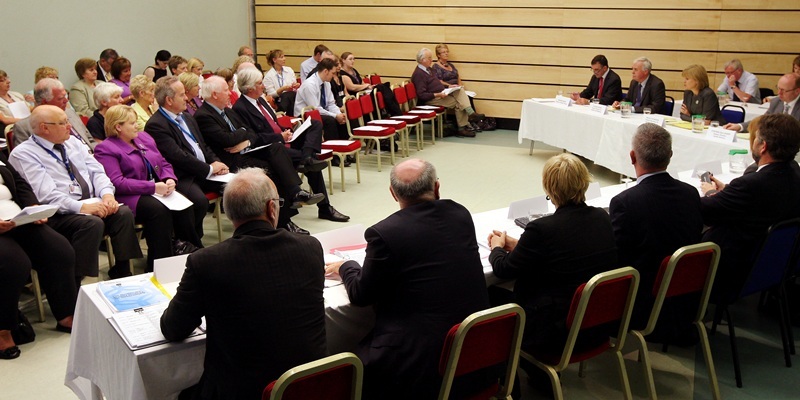NHS FIFE has been accused of coming up with “weak” answers to health secretary Nicola Sturgeon’s questions during its annual review on Tuesday.
Councillor Andrew Rodger, who claims patients are left waiting on trolleys because of a shortage of hospital beds in Fife, said he was not convinced by the health board’s “nervous” performance at Victoria Hospital, Kirkcaldy.
The fact Ms Sturgeon had changed her plans in order to chair the review when public health minister Shona Robison had been set to attend because of recent staffing problems at Victoria’s A&E unit was “an embarrassment,” he said.
“I welcomed the opportunity to attend and that the minister, to her credit, was there and didn’t leave it to her deputy. I welcome the fact she recognised the problem of delayed discharges, and that is going to be tackled in the future.
“But some answers the board gave were very weak, and they seemed to be well versed on what they were going to be asked.
“The chief executive John Wilson did not answer my questions, in particular regarding people lying on trolleys.”
Mr Rodger is still demanding answers to why Victoria’s ward 13 was closed down when he understood from staff that Fife hospital beds are at almost full capacity.
He added, “I believe there will be changes to the top management in Fife and I believe there could be changes at the top level of the board, because I didn’t see a confident delivery on the day.
“And it was not good for a minister to be put in that position by a senior management team.”
During the meeting, NHS Fife was quizzed on its failure to meet the target of 98% of patients being admitted, discharged or transferred from A&E within four hours of arrival. The compliance rate was 96.7% in the quarter to March 2010.
Mr Wilson, chief executive of the operational division, said the statistic reflected the staffing issues experienced at A&E.
He added, “We do have regular meetings and weekly reports, and we analyse all breaches,” he said.
Ms Sturgeon raised the issue of delayed discharges. Earlier this year, NHS Fife was praised for bringing discharges beyond six weeks down to zero.
NHS Fife chief executive George Brechin said six weeks should not be a target but a limit “beyond which we should not go.”
Operational division chairman Professor Jim McGoldrick said it should be possible to prepare patients to leave hospital much sooner.
“An awful lot of people could be waiting three, four or five weeks, when they could be released in one or two,” he said.
Ms Sturgeon congratulated NHS Fife for bringing down rates of clostridum difficile. However the region is still struggling to address staphylococcus aureus bacteraemia (SABS) infections such as MRSA and MSSA.
While MRSA has decreased, MSSA has increased. Professor McGoldrick said NHS Fife had an ongoing problem with SABS infections acquired in the community 40% of SABS is community-acquired and work was ongoing to address the problem.
Ms Sturgeon asked the board how they had responded to hygiene issues at Queen Margaret Hospital in Dunfermline earlier this month. In February the hospital was rapped after inspectors found dirty mattresses and stained bed linen.
Mr Wilson said all actions agreed to address the issues were set to be complete by the end of the month.
Sickness absences among NHS Fife staff was described as still being a “challenge.”
Director of human resources Rona King said the heath board planned to use questionnaires to understand why people were going off sick and, where possible, prevent absences.
Ms Sturgeon raised the issue of delayed discharges. Earlier this year, NHS Fife was praised for bringing discharges beyond six weeks down to zero.
NHS Fife chief executive George Brechin said six weeks should not be a target but a limit “beyond which we should not go.”
Operational division chairman Professor Jim McGoldrick said it should be possible to prepare patients to leave hospital much sooner.
“An awful lot of people could be waiting three, four or five weeks, when they could be released in one or two,” he said.
Ms Sturgeon congratulated NHS Fife for bringing down rates of clostridum difficile. However the region is still struggling to address staphylococcus aureus bacteraemia (SABS) infections such as MRSA and MSSA.
While MRSA has decreased, MSSA has increased. Professor McGoldrick said NHS Fife had an ongoing problem with SABS infections acquired in the community 40% of SABS is community-acquired and work was ongoing to address the problem.
Ms Sturgeon asked the board how they had responded to hygiene issues at Queen Margaret Hospital in Dunfermline earlier this month. In February the hospital was rapped after inspectors found dirty mattresses and stained bed linen.
Mr Wilson said all actions agreed to address the issues were set to be complete by the end of the month.
Sickness absences among NHS Fife staff was described as still being a “challenge.”
Director of human resources Rona King said the heath board planned to use questionnaires to understand why people were going off sick and, where possible, prevent absences.
